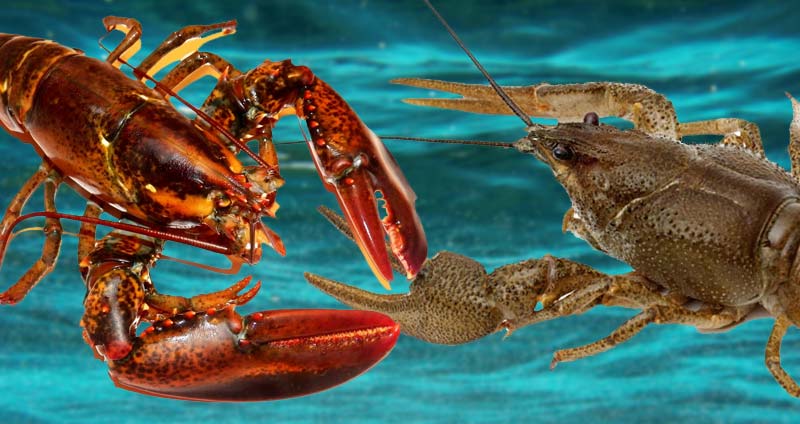Crayfish and lobsters are close relatives. That’s why they look so much alike, and people seem to confuse the two.
They may taste the same when cooked and look the same while alive, but several differences set them apart.
Let’s check out the difference between both!
Table of Contents
Appearance
Crayfish and lobsters may look identical to the untrained eye. But each has characteristics that make it unique.
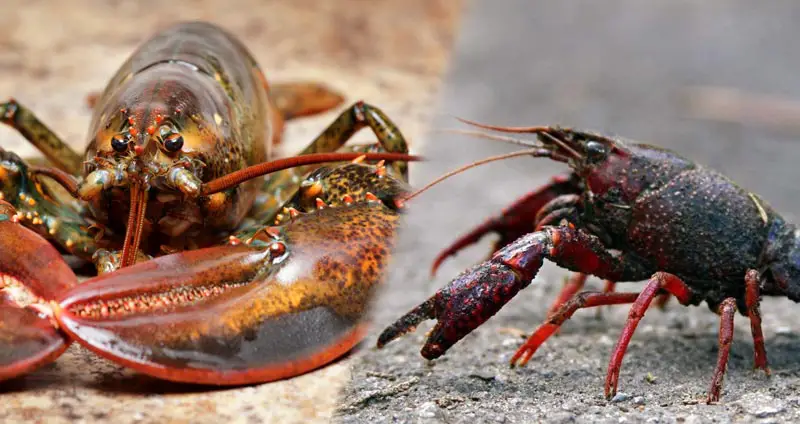
Crayfish
Crayfish, also known as crawfish or crawdads, are part of the ‘small lobster’ invertebrate, arthropod family. They can reach a length of 6 inches, weigh about 8 lbs, and have a lifespan of 2 to 3 years.
They have a hard exoskeleton to protect their inner tissues and vital organs. Their exoskeleton can be yellow, pink, orange, brown, or greenish-blue. Crayfish are constantly shedding and regrowing their exoskeleton.
Their carapace, the part of the exoskeleton that protects the head and vital organs, is hard, yet smooth. Crayfish take in oxygen with their feather-like gills.
Crayfish use their two front claws to crush and tear their food apart. They have five pairs of walking legs in the front. There are also five pairs of smaller limbs, called swimmerets, that end in pincers.
Lobsters
Lobsters belong to the invertebrate arthropod family. They can live up to 50 years, sometimes longer. Lobsters can be 25 to 50 cm long. Their average weight ranges from 1 lb to almost 4 lbs. They breathe through gills found at the ends of their legs.
Their outer covering is more flexible than other arthropods. Their carapace isn’t as smooth as that of the crayfish.
Lobsters have dark exoskeletons and mainly depend on their natural environment. This helps protect hide from predators.
American lobsters have a darker brown or green color, while those in Europe have a deep shade of blue. Their joints are more colorful, with specks of orange or red.
In addition to their five pairs of legs, lobsters are known for their unequal, yet large claws. They protect them against predators, as well as attack, catch and tear their prey.
One of their claws is known as the ‘sharp crusher claw.’ It’s the bigger of the two and helps crush and tear up their prey’s hard shell. Then there’s the pincer claw which is sharp and razor-like. It helps tear up their food.
A fun fact is that lobsters can grow a new claw if one gets cut off. Like crayfish, lobsters shed their exoskeleton and regrow a new one in a process known as ‘molting’.
In adult lobsters, this can take place once or twice per year for 5 to 7 years. During that time, they have to remain vigilant of predators since their outer covering is soft and vulnerable.
Habitat
Even though they have similar features, one of their differences is their habitat.

Crayfish
Crayfish are freshwater crustaceans. They can be found in lakes, rivers, creeks, streams, and dams. They’re usually found lurking at the bottom. They burrow under grass beds, rocks, and in crevices.
Lobsters
Lobsters are considered marine animals. They can be found in cold oceans and seas. They like burrowing in rocks, under grass beds, and in crevices where predators can’t find them. Young lobsters that are still settling on the bottom burrow in sand, clay, and pebbles.
Behavior
Both crustaceans are good at creating burrows for shelter and protection.
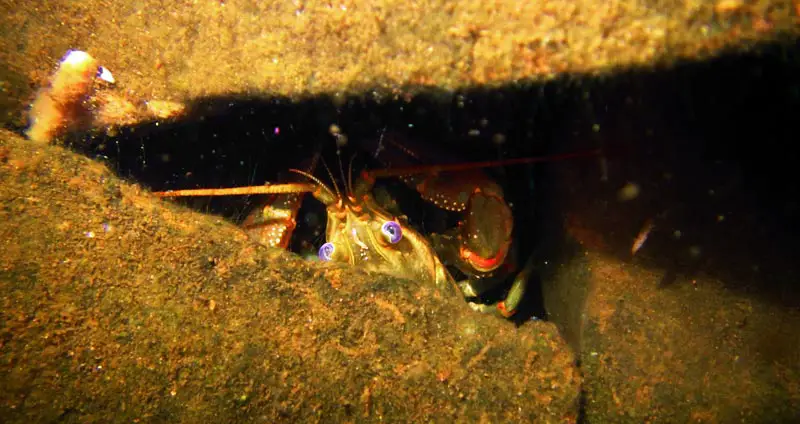
Crayfish
All crayfish can burrow under logs and rocks to stay hidden from predators. They’re mostly slow crawlers, and use their walking legs to stroll around. Yet once they feel threatened, they use their tails to quickly swim back to their burrows for safety.
They’re nocturnal, so tend to hide most during the day and are more active during the night when they come out to hunt.
Lobsters
Lobsters are also mainly nocturnal. They hunt for their food at night and remain inactive during the day. They’re known for their slow movements across the seabed floor. But if threatened, they can retreat quickly to escape their predators.
They’re good at creating shelters by digging under grass beds, sand, and clay. They fan out silt and debris and create a modified entrance using rocks and pebbles. To prepare for molting, they may even block the entrance for up to two weeks as a measure of protection.
Diet
Crayfish and lobsters are both bottom-dwellers who forage for food at night.
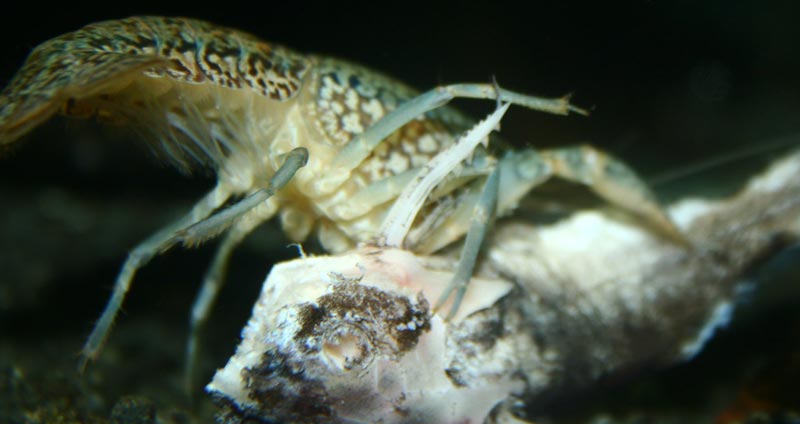
Crayfish
Crayfish are considered to be scavenger feeders. They feed on insects, worms, mollusks, insect larvae, tadpoles, amphibian eggs, and aquatic plants. Sometimes, they can be fortunate enough to find small birds or rodents to feed on. They also feed on detritus.
They’re known for consuming a variety of foods because they eat anywhere from 1 to 4% of their body weight daily. As they mature, this percentage decreases gradually.
Lobsters
The two lobster claws enable them to feed on different types of prey. Lobsters aren’t picky eaters.
They’ll eat anything they can, even if that means eating dead organisms, or even plants. Their main diet consists of small fish, crabs, starfish, mussels, and sea urchins.
Taste
Crayfish meat has a similar taste to lobster. They both have a savory, appetizing flavor.
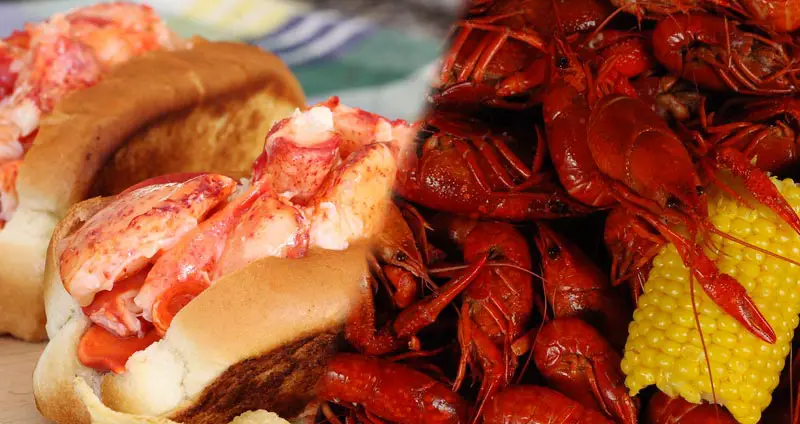
Crayfish
Crayfish can be prepared by boiling or steaming them. Only a small part of the crayfish is edible, as with all edible crustaceans. They can be added to dishes such as soups, etouffee, bisques, or jambalaya.
Crayfish are usually prepared with Cajun seasoning. This includes oregano, cayenne, paprika, garlic, and other ingredients, giving it a tinge of sweetness more than a salty taste. They’re low in fat and calories and high in proteins. They’re also rich in iron, vitamin B12, niacin (vitamin B3), copper, and selenium.
Lobsters
The main way to cook lobster is to boil, bake, or steam it. Once cooked, its color changes to bright orange. Since lobsters are bigger than crayfish, this means there’s more meat to eat.
This is why there are a variety of lobster recipes, such as bisque, soups, lobster rolls, lobster Newburg, and many more.
Lobster meat has low levels of cholesterol, saturated fats, and calories. It’s also high in protein and omega-3 fatty acids. Lobsters are also rich in minerals, such as calcium, zinc, phosphorus, potassium, as well as vitamins B and A.
Conclusion
When you face a crayfish vs. lobster dilemma, you can tell them apart by examining their length, claws, and water habitat.
If you’re the one doing the catching, then just see whether you were fishing in freshwater or saltwater. If you’re buying, ask the person in charge.
If it has uneven claws, is longer than 6 inches, and comes from saltwater, then it’s a lobster. If it has even claws, is on the shorter side, and comes from a freshwater habitat, then it’s a crayfish.

